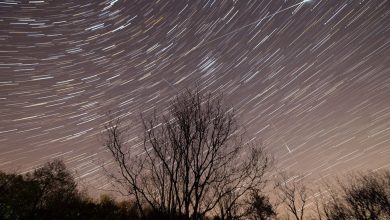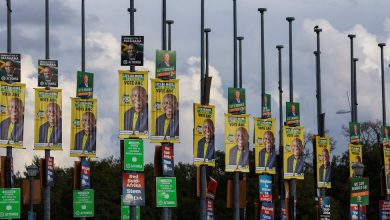To Learn Bees’ Secrets, Count Them One by One

All through late summer and early fall, Max McCarthy, a graduate student at Rutgers University, walked around wetlands in northern New Jersey with a mesh net catching bees, which he marked with tiny colored pens. Three dots, each a different color, on the bees’ minuscule thoraxes before releasing them again. He wrote this information in his notebooks, counting up the insects one by one.
These are not just any bees. Mr. McCarthy, is hunting a rare bee called Andrena parnassiae. The species is only found near a flowering plant called grass of Parnassus, which, in the Northeast United States, only grows in alkaline wetlands, or fens.
By tagging the bees, Mr. McCarthy, along with his adviser Rachael Winfree, an ecologist at Rutgers, is trying to see how easily these insects can move between habitat patches, and how far. As their ecosystem is disrupted by climate change, development and invasive species, how well will the insects adapt?
The researchers hope their data about this little-known species will shed light on an urgent and complex issue: pollinator decline.
Pollinators, which include bees, serve vital roles in natural ecosystems. Nearly 90 percent of flowering plants rely on animal pollinators to reproduce, and around 35 percent of the world’s crops are also dependent on pollinators. The economic value of bees is estimated to be tens, if not hundreds, of billions of dollars. Although domesticated pollinators like honeybees can be used as agricultural substitutes, they cannot completely fill the role of wild pollinators.
Despite this gravity, the scale of pollinator decline is not well understood. What the scientific community does know comes from a small selection of local studies and anecdotal evidence from older naturalists.
“There are some strong indications that pollinator populations have declined dramatically, but we’re just beginning to understand how deep and how wide the problem is,” said David Wilcove, a professor of conservation biology and public policy at Princeton University who is not involved in Mr. McCarthy and Dr. Winfree’s research.
Understanding which species are declining, why, and how they react to changing habitats could help scientists anticipate these sorts of environmental shifts. “People don’t like to count bugs, but the people who do count them can tell us things that no one else can,” Dr. Wilcove added.
Bees are the most robust pollinators in North America. But in the United States, the only longstanding research on bees has been on the genus Bombus, the bumblebee, and it is difficult to know whether these data are relevant to the hundreds of other groups of bees in the country. No state, except for Pennsylvania, has even a partial list of its native bee species.

A bee temporarily detained in a tube as Mr. McCarthy observed and catalogued it.Credit…Jonno Rattman for The New York Times
There are technical reasons for this scarcity in bee population data. Bees are small, “and identification is just wicked hard,” Dr. Winfree said. In order to track their movement and count their population size, she explained, bees must be monitored individually.
What can help researchers is narrowing where the bees could be. But bees that only pollinate specific plants, like blueberries, are also hard to track because the plants are generally too widespread.
Mr. McCarthy, however, is able to know the location of every A. parnassiaepopulation in northern Jersey because they will always be found around grass of Parnassus, which only grows in fens. “There are lots of bees that are specialized, but fewer that are specialized on plants that are also specialized,” he said.
Although Mr. McCarthy is just in his second year of research, he probably knows more about A. parnassiae’s behaviorthan any other scientist alive — partly because the species is rare (it’s only been documented in a couple states), and partly because it pollinates in fens, which have little agricultural value. Dr. Winfree even pointed out, while standing next to a blooming Parnassus, that Mr. McCarthy was the first to spot the bee in the area. It hadn’t been seen in New Jersey until last year.
The duo had driven up to a small fen in late summer on the edge of White Lake, in Hardwick Township. Mr. McCarthy had walked around the area for 30 minutes, catching 10 bees with practiced flicks of his net. Sitting under a tree with one of the insects in hand, he peered through his glasses at its back, which was covered in pollen. Plucking a thorn from a nearby Japanese barberry bush, he scraped the yellow dust off, revealing three painted dots underneath. Blue, yellow and white. He had already marked this one. He wrote “BYW” in his notebook, and released the bee.
It’s tedious work, but Mr. McCarthy and Dr. Winfree hope their findings — on the local population size, and whether the insects are moving between fens — can serve as a data point in the global issue of pollinator decline. How resilient will the animals be to habitat destruction? How quickly are they dying off? To answer these questions, start with a single bee.




